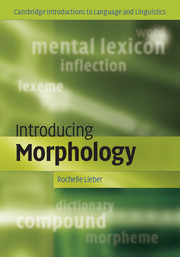Book contents
- Frontmatter
- Contents
- Preface
- The International Phonetic Alphabet
- Point and manner of articulation of English consonants and vowels
- 1 What is morphology?
- 2 Words, dictionaries, and the mental lexicon
- 3 Lexeme formation: the familiar
- 4 Productivity and creativity
- 5 Lexeme formation: further afield
- 6 Inflection
- 7 Typology
- 8 Words and sentences: the interface between morphology and syntax
- 9 Sounds and shapes: the interface between morphology and phonology
- 10 Theoretical challenges
- Glossary
- References
- Index
6 - Inflection
- Frontmatter
- Contents
- Preface
- The International Phonetic Alphabet
- Point and manner of articulation of English consonants and vowels
- 1 What is morphology?
- 2 Words, dictionaries, and the mental lexicon
- 3 Lexeme formation: the familiar
- 4 Productivity and creativity
- 5 Lexeme formation: further afield
- 6 Inflection
- 7 Typology
- 8 Words and sentences: the interface between morphology and syntax
- 9 Sounds and shapes: the interface between morphology and phonology
- 10 Theoretical challenges
- Glossary
- References
- Index
Summary
CHAPTER OUTLINE
In this chapter you will learn about inflection, the sort of morphology that expresses grammatical distinctions.
We will look at a wide variety of types of inflection, both familiar and unfamiliar, including number, person, gender and noun class, case, tense and aspect, voice, mood and modality.
We will learn what morphologists mean by a ‘paradigm’ and look at patterns within paradigms.
And we will consider whether it is always clear where to draw the line between inflection and derivation.
KEY TERMS
person, number, gender, case, tense, aspect, inherent, contextual, paradigm
Introduction
At the outset of this book we divided morphology into two domains inflectional and derivational word formation. In the last three chapters, we have concentrated on derivational word formation – types of word formation that create new lexemes. In this chapter, we turn our attention to inflectional word formation.
Inflection refers to word formation that does not change category and does not create new lexemes, but rather changes the form of lexemes so that they fit into different grammatical contexts. As we'll see in detail below, grammatical meaning can include information about number (singular vs. plural), person (first, second, third), tense (past, present, future), and other distinctions as well. In this chapter, we will first survey different forms of inflection that can be found both in English and familiar languages, and further afield in the languages of the world, and then look at the ways in which inflection can work.
- Type
- Chapter
- Information
- Introducing Morphology , pp. 87 - 116Publisher: Cambridge University PressPrint publication year: 2009



